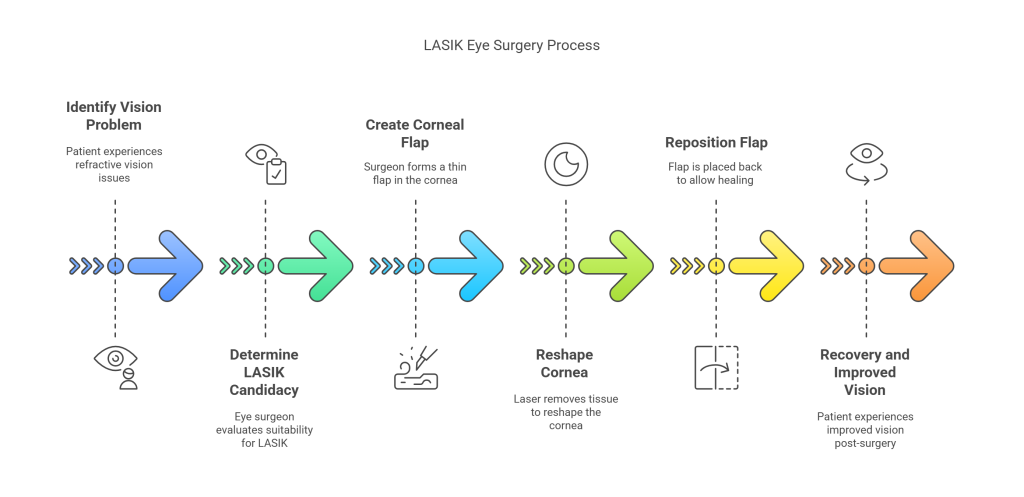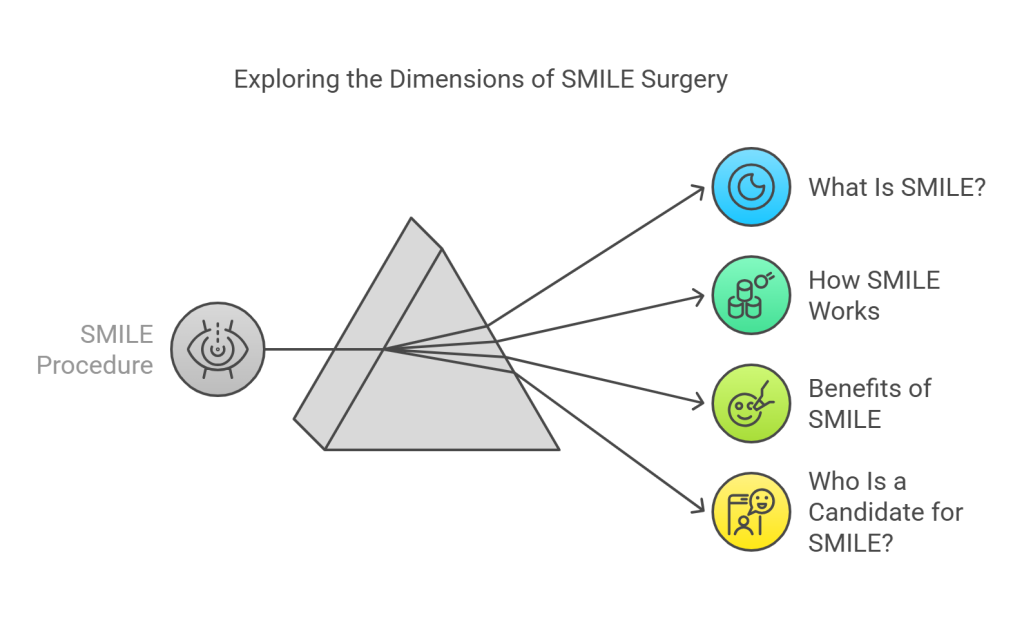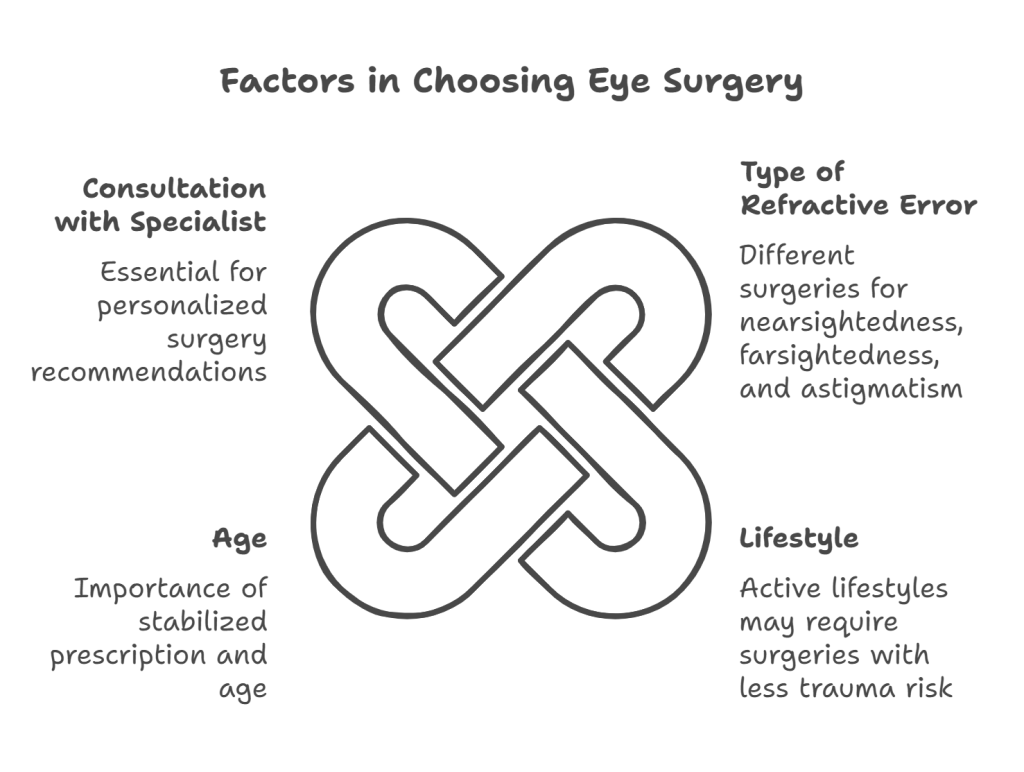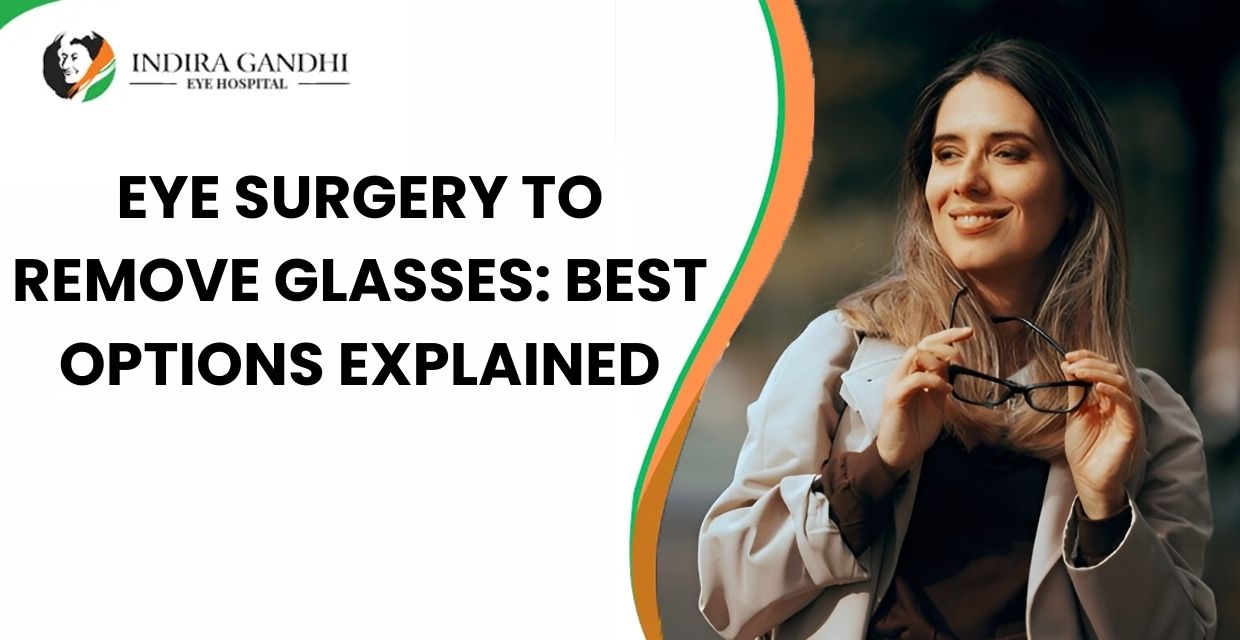|
Getting your Trinity Audio player ready...
|
Eye Surgery to Remove Glasses :- If you’re tired of wearing glasses or contact lenses, you’re not alone. Many people feel restricted by their need for corrective lenses, whether it’s for daily activities, sports, or simply for aesthetic reasons. Fortunately, modern advancements in eye surgery have made it possible to permanently correct vision issues and eliminate the need for glasses. Eye surgery to remove glasses is now a common solution for those seeking clearer vision without the hassle of lenses. But which eye surgery is right for you? In this blog, we’ll walk you through the best options available, their benefits, and what you need to know before considering eye surgery to remove glasses.
What Is Eye Surgery to Remove Glasses?

Eye surgery to remove glasses refers to procedures that correct refractive vision problems, such as nearsightedness (myopia), farsightedness (hyperopia), and astigmatism, allowing patients to see clearly without relying on glasses or contact lenses. These surgeries work by reshaping the cornea, the clear front part of the eye, to improve its focus. The goal is to allow light entering the eye to focus directly on the retina, eliminating the need for external corrective lenses.
If you’ve been wondering whether eye surgery could be an option for you, keep reading to explore the most popular and effective procedures available.
1. LASIK (Laser-Assisted in Situ Keratomileusis)
What Is LASIK?
LASIK is one of the most well-known and widely performed eye surgeries to remove glasses. The procedure uses a laser to reshape the cornea, improving its ability to focus light onto the retina. LASIK is ideal for those with nearsightedness, farsightedness, and astigmatism.
How LASIK Works
During the LASIK procedure, the surgeon creates a thin flap in the cornea using a laser or a microkeratome (a small surgical instrument). The flap is then lifted, and a laser is used to remove tiny amounts of tissue from the cornea, reshaping it. Once the cornea has been reshaped, the flap is repositioned, and the eye begins to heal quickly. The entire procedure usually takes around 10 to 15 minutes per eye, and the recovery time is relatively short, with most people noticing improved vision within a few days.
Benefits of LASIK
- Quick recovery: Most patients notice improved vision within a day or two, and full recovery can take just a few weeks.
- Minimal discomfort: LASIK is generally painless, with only mild discomfort reported during recovery.
- No more glasses: After LASIK, many patients achieve 20/25 vision or better, meaning they can live their daily lives without needing glasses or contact lenses.
Who Is a Candidate for LASIK?
LASIK is a great option for individuals over the age of 18 with a stable prescription. If you have severe refractive errors, thin corneas, or other eye conditions like cataracts or glaucoma, LASIK might not be the best choice. Your eye surgeon will evaluate your eyes and determine whether LASIK is right for you.
2. SMILE (Small Incision Lenticule Extraction)

What Is SMILE?
SMILE is a newer and less invasive laser surgery option to remove glasses. It is similar to LASIK in that it reshapes the cornea to correct vision, but it differs in the way it is performed. Instead of creating a flap, SMILE uses a laser to create a small, lens-shaped piece of tissue within the cornea, which is then removed through a small incision.
How SMILE Works
During the procedure, the surgeon uses a femtosecond laser to create a small lenticule (a disc of corneal tissue) inside the cornea. A tiny incision is made to remove the lenticule, reshaping the cornea to correct the refractive error. SMILE is considered minimally invasive because it involves a smaller incision than LASIK and does not require a flap to be created.
Benefits of SMILE
- Fewer complications: Since SMILE involves a smaller incision and no flap creation, there is less risk of complications such as flap dislocation.
- Quick recovery: Like LASIK, most patients experience a rapid recovery, with vision improving in just a few days.
- Ideal for active individuals: The procedure’s minimally invasive nature makes it a good option for athletes or people involved in high-contact sports, as it reduces the risk of flap-related injuries.
Who Is a Candidate for SMILE?
SMILE is mainly recommended for individuals with nearsightedness or astigmatism. It is not yet a widely available option for farsighted individuals. The procedure is still being studied and refined, but it offers promising results for many patients.
3. PRK (Photorefractive Keratectomy)
What Is PRK?
PRK is another well-established laser eye surgery option for people who want to remove glasses. Unlike LASIK, PRK does not involve creating a corneal flap. Instead, the surgeon removes the thin outer layer of the cornea (the epithelium) and uses a laser to reshape the underlying corneal tissue.
How PRK Works
The surgeon first removes the outer layer of the cornea and uses an excimer laser to reshape the corneal tissue beneath it. Once the laser reshaping is complete, the epithelium regenerates naturally, and the eye begins to heal. While PRK offers similar benefits to LASIK, it involves a slightly longer recovery time due to the healing of the outer layer.
Benefits of PRK
- No risk of flap complications: Since there is no flap involved, PRK eliminates the risk of flap-related issues, which can occur in LASIK.
- Suitable for thin corneas: PRK is an excellent option for individuals who may not be candidates for LASIK due to thin corneas.
- Proven success: PRK has been around for decades, and its results have been well-documented.
Who Is a Candidate for PRK?
PRK is suitable for individuals with mild to moderate nearsightedness, farsightedness, or astigmatism. It may be ideal for people with thin corneas or those who have certain lifestyle factors that make LASIK less suitable.
4. ICL (Implantable Collamer Lens)
What Is ICL?
An implantable collamer lens (ICL) is a type of vision correction surgery in which a lens is surgically implanted into the eye to correct refractive errors. Unlike LASIK and PRK, ICL does not involve reshaping the cornea but instead adds an additional lens inside the eye, much like a contact lens but permanently placed inside the eye.
How ICL Works
ICL surgery involves inserting a small lens between the eye’s natural lens and the iris to correct refractive errors. The lens is made from a biocompatible material called collamer, which integrates well with the eye’s natural tissues. The procedure is minimally invasive, and the lens can be removed or replaced if necessary.
Benefits of ICL
- Minimal risk of complications: ICL does not involve reshaping the cornea, which reduces the risk of certain complications.
- Good for high prescriptions: ICL is often recommended for individuals with high levels of nearsightedness or farsightedness that may not be effectively treated with LASIK or PRK.
- No permanent changes to the cornea: Since the lens is removable, ICL offers flexibility for those who may need to adjust their prescription in the future.
Who Is a Candidate for ICL?
ICL is suitable for people with severe nearsightedness or farsightedness who may not be candidates for LASIK or other procedures. It is also ideal for individuals with thin corneas or those who are not suitable for corneal-based surgery.
How to Choose the Right Eye Surgery to Remove Glasses

Choosing the right eye surgery to remove glasses depends on several factors, including your vision prescription, the health of your eyes, and your lifestyle. Here are some things to consider when selecting an option:
- Type of refractive error: LASIK and SMILE are excellent for nearsightedness, farsightedness, and astigmatism, but PRK may be better for people with thin corneas.
- Lifestyle: If you are active in sports or have a higher risk of eye trauma, SMILE or PRK may be better options as they are less prone to flap complications.
- Age: It’s important to wait until your prescription has stabilized before considering surgery. Most surgeons recommend that patients be at least 18 years old before undergoing eye surgery.
- Consultation with an eye specialist: An eye surgeon will perform a thorough eye exam and discuss your options to determine which procedure is right for you.
Frequently Asked Questions (FAQs)
What Is the Best Surgery to Remove Glasses?
The best surgery for you depends on factors such as your prescription, eye health, and lifestyle. LASIK is the most popular choice, but SMILE and PRK are excellent alternatives, depending on your specific needs.
2. How Long Does It Take to Recover from Eye Surgery to Remove Glasses?
Recovery times vary. LASIK offers a quick recovery, with most patients seeing improvement within a few days. PRK may take longer due to the healing of the outer layer of the cornea.
3. Is Eye Surgery to Remove Glasses Safe?
Yes, eye surgery to remove glasses is generally safe when performed by an experienced and qualified surgeon. However, like any surgery, there are risks, and it’s essential to follow your doctor’s post-operative care instructions.
4. How Much Does Eye Surgery to Remove Glasses Cost?
The cost of eye surgery to remove glasses varies depending on the procedure, location, and surgeon. On average, LASIK costs between $2,000 to $3,000 per eye, with other procedures like SMILE and PRK priced similarly.
4. How Much Does Eye Surgery to Remove Glasses Cost?
The cost of eye surgery to remove glasses varies depending on the procedure, location, and surgeon. On average, LASIK costs between $2,000 to $3,000 per eye, with other procedures like SMILE and PRK priced similarly.
5. Am I a Good Candidate for Eye Surgery?
Good candidates for eye surgery are typically over 18 years old, have stable vision, and are free of major eye conditions. Your eye doctor will evaluate your eyes to determine if you’re a suitable candidate.
Conclusion
Eye surgery to remove glasses offers a life-changing solution for people who no longer want to rely on corrective lenses. Whether you choose LASIK, SMILE, PRK, or ICL, the technology available today provides patients with a safe and effective way to achieve clear vision. If you’re considering eye surgery to remove glasses, schedule a consultation with an experienced eye specialist who can guide you toward the best option for your needs.












